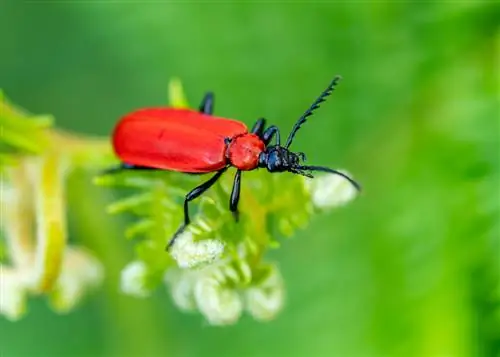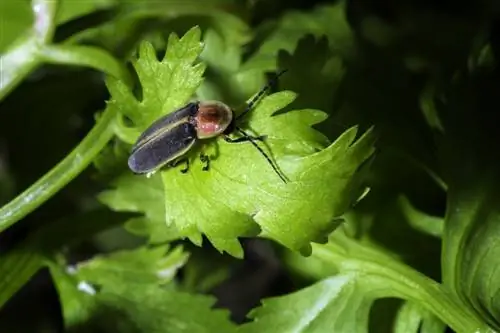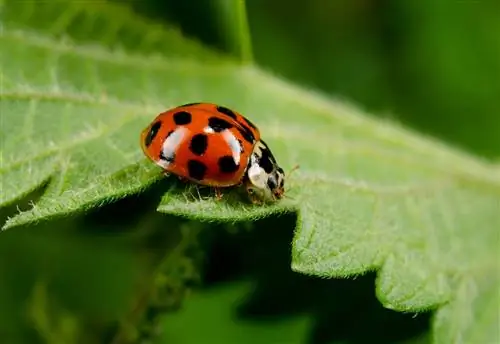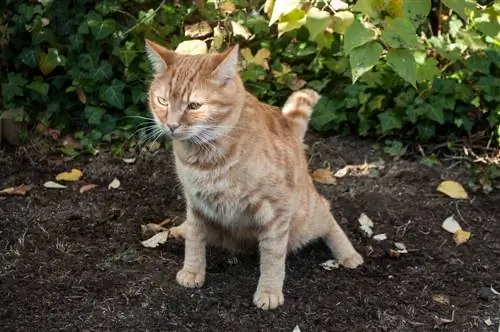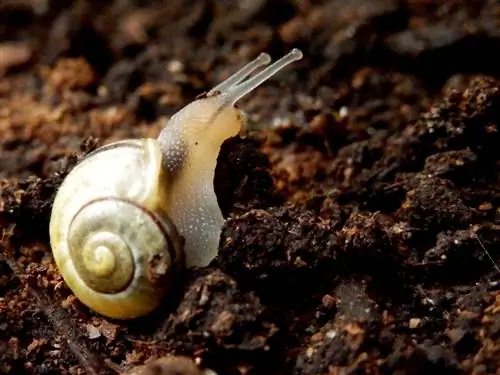- Author admin [email protected].
- Public 2023-12-16 16:46.
- Last modified 2025-06-01 06:02.
Little red beetles sparkle unmistakably in the garden. What type of beetle might it be? Is it a pest, nuisance or beneficial? We invite you to take a stroll through the species-rich world of red beetles in Germany. Informative short portraits provide practical assistance in recognizing red beetles and calling them by their correct names.
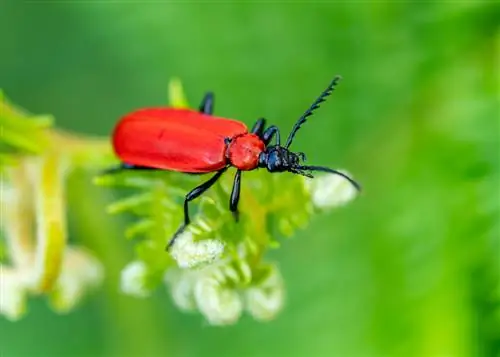
Which red beetles are common in the garden and are they harmful?
Red beetles in German gardens are often beneficial or pests, such as fire beetles, ladybirds, red-capped beetles and fire bugs. Only the lily hen is considered a pest because it eats holes in lilies and other plants. Control lily chickens organically with water showers and soap solutions.
- Common red beetles in Germany are: lily cockerel, fire beetle, ladybird, red cap beetle, fire bug and nasturtium beetle.
- Red mini beetles in the garden are not pests, but mostly beneficial insects or, at worst, nuisances.
- The only exception are bright red lily chicks that eat flowers and leaves. Natural remedies include shaking off, showering, soap solution, algae lime or rock dust.
Identifying red beetles - appearance, characteristics, location
In the natural garden, prudence reigns when many small red beetles appear on the scene. In view of the large number of insect deaths, responsible hobby gardeners investigate which type of beetle visits the plants. Gone are the days of widespread plagues that destroyed crops and devastated entire areas. Even the once feared May beetles and Colorado potato beetles have lost their fear. Pests that require extensive control measures are now few and far between. In fact, the vast majority of German beetles operate as beneficial insects or, at worst, as nuisances. Unfortunately, the Red List of Threatened Insects gets longer every year.
The following table provides an overview of the appearance, special characteristics and typical location as important criteria for accurately identifying red beetles in Germany's gardens:
| Red Beetles | Lily Chicken | Firebugs | Ladybug | Red-covered Beetle | Firebug | Nasturtium beetle |
|---|---|---|---|---|---|---|
| Status | Pest | Beneficial insect | Beneficial insect | Beneficial insect | Troublemaker | endangered Red List |
| Size | 6-9mm | 14-18 mm | 5-8mm | 5-9mm | 6-12mm | 6-15mm |
| Body shape | slim | flat, elongated | spherical | elongated | oval | roll-shaped |
| Special feature | with long antennae | black head | with black dots | red stripes lengthwise | with black pattern | black head |
| Common Location | to lilies | on flowers | in the bed | in the wood | on the tree | Deadwood, firewood |
| Botanical name | Lilioceris lilii | Pyrochroa coccinea | Coccinella septempunctata | Platycis minutus | Pyrrhocoris apterus | Bostrichus capucinus |
| Middle name | Lily Beetle | Scarlet Fire Beetle | Sevenpoint | Small red-capped beetle | Firebugs | Carmine nasturtium beetle |
You can read more in-depth information about these red beetles, which are common in Germany, in the following short portraits:
Lily chick (Lilioceris lilii)
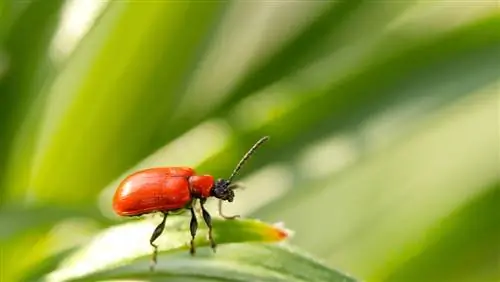
The lily chicken can cause a lot of damage in the garden
Lacquer red cover wings, black legs and antennae reveal the presence of lily chickens in the bed. Informed hobby gardeners do not fall for this decorative deception. In fact, the little red beetles can cause great damage to the garden with their fatal food preferences. The nasty larvae in the brown poop bag in particular are voracious pests. In the garden, on balconies and terraces, lily beetles have these plants in their sights:
- Lilies of all kinds
- Imperial Crowns
- Lily of the valley
- Daffodils
- Checkerboard flowers
- Chives
Fire beetle (Pyrochroa coccinea)
Elytra and pronotum are fiery red. Pitch-black wings, antennae, head and legs create contrasts worth seeing. The long antennae, which are sawn in females and combed in males, are striking. To spot a red beetle with these attributes, look for the following locations:
- On flowers
- On plants with aphid colonies
- On deciduous trees
- In flower hedges and mixed hedges
Because the fire beetle larvae on the tree under the bark enthusiastically hunt and kill bark beetle larvae, the categorization as a beneficial insect is quite legitimate.
Seven-spot ladybird (Coccinella septempunctata)
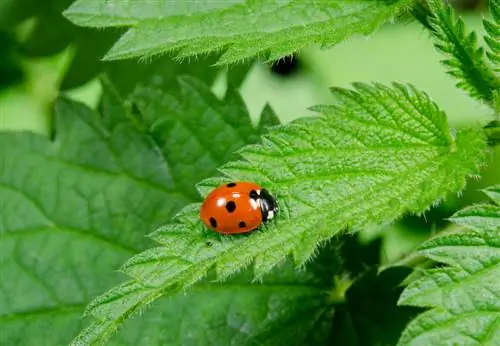
The seven-spot ladybird is native to us, but is gradually being replaced by the Asian species
As a red beetle with seven black spots, the ladybird has taken people's hearts by storm. Each red elytra is decorated with three black dots. The eponymous seventh point is located in the middle of the front edge and extends over both wings. Two white corners can be admired on the black pronotum. From April to October the flying lucky charm can be found here:
- On plants with aphids
- On the house wall (in autumn)
In contrast to the native seven-spot, the immigrant Asian lady beetle (Harmonia axyridis) likes to boast of shiny black cover wings that are decorated with several red dots. The beneficial insect lives up to its second name, the harlequin ladybird, with varied colors, such as light yellow wings with black dots, dark red wings with black spots or monochrome cover wings without a pattern.
Tip
A black and red beetle in a striped dress goes by the name stripe bug (Graphosoma lineatum). Trademarks are black and red stripes that decorate its 10 to 12 mm long body on the top. Black dots on the red underside spice up the eye-catching costume. The distinctive, beetle-like insect is a harmless guest in the garden and not a pest.
Red-covered beetle (Platycis minutus)
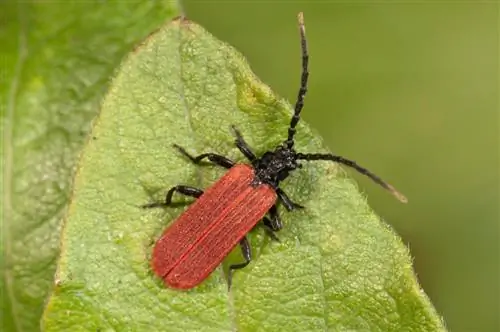
The small red-capped beetle looks slightly similar to the lily cockerel, but is significantly smaller and less bright
Representing seven picturesque red-capped beetle species in Germany, the small red-capped beetle should be mentioned here. The mini beetle has bright red, grooved wing covers and a black pronotum. In relation to its body size, the tiny creature boasts epically long, black antennae. The best chances of encountering this natural jewel are at these locations:
- In the garden, preferably on flowers and in green dry stone walls
- In the forest, mostly on deciduous trees
- In a cemetery with old trees, often in fungal dead wood
The red-capped beetle owes its status as a beneficial insect to the insatiable larvae that feed on the eggs and larvae of other insects, many of which are considered pests.
Fire bug (Pyrrhocoris apterus)
As a beetle, the fire bug is a deception. The bright red insect with the distinctive black pattern is one of the bugs (Heteroptera) without a functional flying apparatus. A flat top and curved bottom characterize the oval body outline. There are short antennae on the thick, black head. Favorite food is the juices from plant seeds that have fallen to the ground. Fire bugs like to hang out at the feet of these plants:
- an mallows
- under hibiscus
- on the root disc of robinias
Fire bugs lead a sociable lifestyle. The pretty insects like to gather in droves to enjoy extensive sunbathing on stones. Concerned hobby gardeners fear that a plague is plaguing their garden. In fact, the fire bug is completely harmless. The following video with impressive images explains why the fire bug is wrongly demonized as a pest in the garden:

Nasturtium beetle (Bostrichus capucinus)
The nasturtium beetle owes its name to its brick-red wing coverts and a black, rasped pronotum that covers its black head like a hood. Adult beetles and larvae feed on dead wood, converting the cellulose into valuable humus. Typical locations for the beneficial insects are:
- light forests
- Vineyards
- Orchard meadows
Shrinking habitats and pesticides have put the beautiful nasturtium beetle in distress, causing the Red List to classify its status in Germany as endangered.
Excursus
Red beetles in the house - what to do?
If many small red beetles visit the apartment, they are often ear beetles (Anthocomus equestris). Red elytra with 2 black spots make the 4 mm beetle beauties unmistakable. The larvae enter the house as stowaways in fresh potting soil. This is no cause for concern because the little predators feed on mites and other microorganisms. In early summer, the hatched ear beetles leave their nursery and fly around the house. The black and red beetles often sit on the window pane and look longingly outside. By opening windows and balcony doors for a short time, you release the harmless, peaceful guests into freedom.
Red beetles eat lilies - what to do?
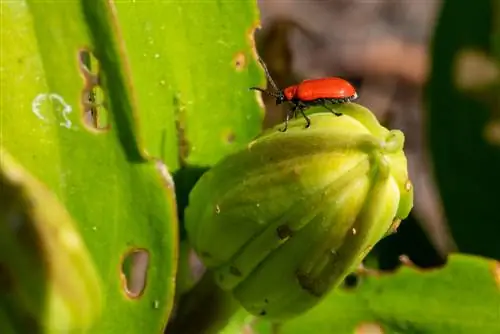
Lily chickens eat holes in lilies and other plants
The only pest among the common red beetles in Germany is the lily hen. The mini beetle is said to have a huge appetite for lilies, imperial crowns, lilies of the valley and herbs, preferably chives. The infestation does not have to develop into a plague in the garden if you use these natural remedies against lily beetles:
- Shake it off: Spread out the foil, shake off the cold-stiff lily chickens in the early morning
- Shower off: spray infected plants from above and below with a powerful jet of water
- Soap solution: Dissolve 15 ml of curd soap, 15 ml of spirit in water, spray every 3-4 days (top and bottom of the leaves)
- Powdering: Apply algae lime or rock powder to leaves and shoots using a powder tip
The stubborn, orange-brown egg packages of busy female lily beetles sometimes resist biological control agents. Please check the undersides of the leaves regularly. Eggs that have been discarded can be wiped off with kitchen paper. Alternatively, tear off affected leaves with a courageous tug.
Frequently asked questions
Little red beetles in the garden eat holes in flowers and leaves. What to do?
Pitting is a typical damage caused by lily chicken infestation. In the early stages you can effectively combat the pests with repeated water showers. Spray infected plants vigorously. Hold the water hose so that you can reach the undersides of the leaves as well. Then treat the plants with a mixture of 1 tablespoon of liquid soap and spirit, dissolved in 1 liter of water.
Small red beetles with a black pattern sit on hibiscus and mallows. Are these pests?
According to your description, these are fire bugs (Pyrrhocoris apterus), also known as fire beetles. The bright red insects with the striking black pattern like to eat the seeds of hibiscus, hollyhocks and other mallow plants. Fire bugs use their tiny proboscis to drill a hole in the seed coat and suck up the nutritious juice. Leaves, flowers and other parts of plants are not part of the food spectrum. For this reason, they are not pests that need to be controlled.
Tip
Nature-oriented gardeners warmly welcome tiny little beetles with red velvet robes into the garden. The velvet mite (Trombidium holosericeum) has arrived. The 2-4 mm small, velvety red insect rushes around on 8 legs, always on the hunt for tasty eggs and juicy larvae. Unfortunately, the velvet mite's downfall is its similarity to the red spider, which is vehemently combated as a pest on apple trees, strawberries and other fruit plants.

